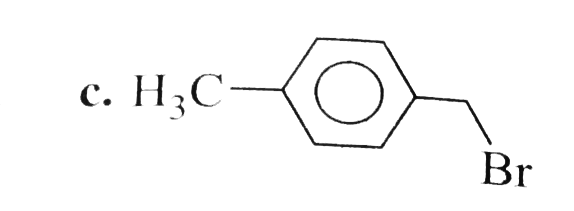Which of the following gives SN1 reaction more easily ?
CH3Cl
C6H5CH2Cl
CH2=CH−CH2−Cl
CH2=CH−Cl
The correct Answer is:B
Compound which produced more stable carbocation undergoes easily SN1 rreaction.
Benzyl carbocation is more stable than allyl, vinyl and methyl carbocation.
Topper's Solved these Questions
- GENERAL PRINCIPLES & PROCESSES OF ISOLATION OF ELEMENTSBOOK - NIKITA PUBLICATIONCHAPTER - GENERAL PRINCIPLES & PROCESSES OF ISOLATION OF ELEMENTSEXERCISE - Multiple choice questions
117 Videos
- MCQs FROM PREVIOUS BOARD QUESTION PAPERS BOOK - NIKITA PUBLICATIONCHAPTER - MCQs FROM PREVIOUS BOARD QUESTION PAPERS EXERCISE - Question Paper- MHT-CET 2018
50 Videos
Similar Questions
Knowledge Check
Which of the following will giveSN2 reaction
AC6H5CH2−XB(CH3)3C−XCCH2=CH−CH2−XDCH3XWhich of the following are SN2 reactions ?
A BMe3C−Br+KOH→Mr3C−OH+KBrCEt−I+EtONa→Et−O−Et+NaIDEt−Cl+NaOH→EtOh+NaCl
BMe3C−Br+KOH→Mr3C−OH+KBrCEt−I+EtONa→Et−O−Et+NaIDEt−Cl+NaOH→EtOh+NaClWhich of the following will give SN2 mechanism?
A B
B C
C D
D
SN reaction is given by these compounds, which have a nuclophilic group and a good leaving EWG. It should be stable after leaving with bonding pair of ¯e's and it should have high polarisability.
Nucliphilic aliphatic substituion reaction is mainly of two types SN−1 and SN2.SN−1 mechanism is a two step process. Reaction velocity of SN−1 depends only on the concentration of the subtrate. It proceeds via the formation of carbocation, optically active substrate gives (⊕) and (o−) froms of the product.
In most of the cases, the product usually consists of 5−20% inverted and (95−80%) racemised species. The more stable is the carbocation, the greater is the propotion of racemission. In solvolysis reaction, the more nucleophillic is the solvent, the greater is the proportion of inversion.
Which of the following gives SN1 reaction?

Select the correct answer.
View SolutionSN reaction is given by these compounds, which have a nuclophilic group and a good leaving EWG. It should be stable after leaving with bonding pair of ¯e's and it should have high polarisability.
Nucliphilic aliphatic substituion reaction is mainly of two types SN−1 and SN2.SN−1 mechanism is a two step process. Reaction velocity of SN−1 depends only on the concentration of the subtrate. It proceeds via the formation of carbocation, optically active substrate gives (⊕) and (o−) froms of the product.
In most of the cases, the product usually consists of 5−20% inverted and (95−80%) racemised species. The more stable is the carbocation, the greater is the propotion of racemission. In solvolysis reaction, the more nucleophillic is the solvent, the greater is the proportion of inversion.
Which of the following gives SN1 reaction?
View SolutionSN2 reaction is a bimolecular reaction which takes places by the formation of T.S. Veolcity of the reaction depends on the concentration of the substrate as well as the nucleophile.
The reaction is favoureed by strong Nuo− and in the presence of polar aprotic sovlent, optically active halides give. Walken inversion by SN2 mechanism. The presence of hero group (atom) at β−C atom, unsaturation at β−C and ⎛⎜ ⎜⎝−O∣∣C−⎞⎟ ⎟⎠ group at α−C atomn favor SN2 mechanism.
Allyl halides and benzyl halides give SN1 and SN2 reactions. Allyl halides alos give SN2 mechanism EDG at ortho- and para- postions in benzyl halides favors SN1 mechanism, wheras EWG favors SN2 mechanism.
Which of the following will give SN1 reaction?
View SolutionSN reaction is given by these compounds, which have a nuclophilic group and a good leaving EWG. It should be stable after leaving with bonding pair of ¯e's and it should have high polarisability.
Nucliphilic aliphatic substituion reaction is mainly of two types SN−1 and SN2.SN−1 mechanism is a two step process. Reaction velocity of SN−1 depends only on the concentration of the subtrate. It proceeds via the formation of carbocation, optically active substrate gives (⊕) and (o−) froms of the product.
In most of the cases, the product usually consists of 5−20% inverted and (95−80%) racemised species. The more stable is the carbocation, the greater is the propotion of racemission. In solvolysis reaction, the more nucleophillic is the solvent, the greater is the proportion of inversion.
Which of the following gives SN1 reaction?
View SolutionSN2 reaction is a bimolecular reaction which takes places by the formation of T.S. Veolcity of the reaction depends on the concentration of the substrate as well as the nucleophile.
The reaction is favoureed by strong Nuo− and in the presence of polar aprotic sovlent, optically active halides give. Walken inversion by SN2 mechanism. The presence of hero group (atom) at β−C atom, unsaturation at β−C and ⎛⎜ ⎜⎝−O∣∣C−⎞⎟ ⎟⎠ group at α−C atomn favor SN2 mechanism.
Allyl halides and benzyl halides give SN1 and SN2 reactions. Allyl halides alos give SN2 mechanism EDG at ortho- and para- postions in benzyl halides favors SN1 mechanism, wheras EWG favors SN2 mechanism.
Which of the following will give SN1 reaction?
View Solution
